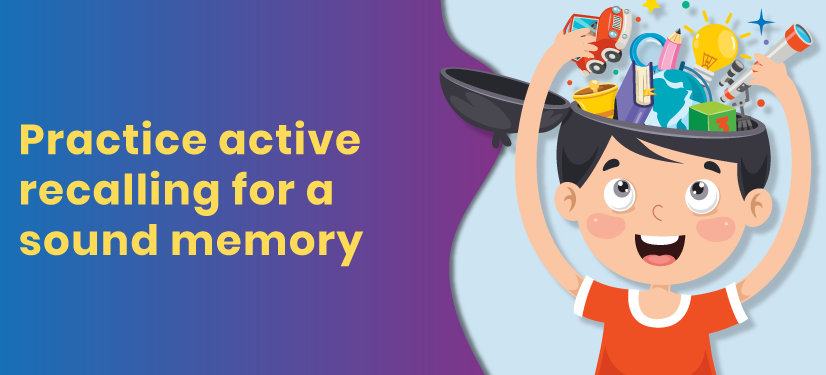
Why students need to harness the power of recall
Our brain is a very powerful organ and the centre of neural decision-making. Strangely, a lot about the brain still remains unknown due to its complex functions. The little information we know tells us that it can be trained to do spectacular things ã…¡ like memorising hundreds of volumes of text or calculating complex multiplication tables, and much more.
While some are naturally gifted with this skill, for a large majority of us, training our brain is the only way to achieve this prowess. However, why is this important to us? Well, in our day-to-day life, especially with regards to learning, a well-trained brain can come very handy.
What is recalling or, more accurately, active recalling?
Recall is what teachers tell students to do after they have gone through a topic. Active recall is a more appropriate variant of the word ‘recall’. Active recall refers to the process of stimulating your memory actively for a piece of information. The word recall can have multiple meanings whereas active recall refers to matters of the mind. Generally, we tend to store information about whatever we learn in our short-term memory. By practising active recall, one can successfully move this information to long-term memory.
This will be useful in the long term, because then you will be able to readily access information when you need it the most. Like, for example, when you are in an examination hall for an assessment test or exam or when the teacher asks you a question in class.
How is review different from active recalling?
In learning, review is what you do prior to recalling. Reviewing is essentially the first step to recalling. Let’s understand this through an example. Suppose your teacher asks you ー what is chlorophyll? You can’t simply answer this question unless you understand the origin of the word “chlorophyll”. You will have to first come to the conclusion that it is related to plants and then start building on that. You will need to go through the subject of photosynthesis and have previous knowledge of how plants make food. When you can’t remember something, the review will act as your fallback position.
On the other hand recalling is when you try remembering without using any material or tools by simply drawing from your memory. This step is much harder than reviewing because you do not have any notes to fallback on and this is also the reason why many of us struggle with remembering stuff. If you are not capable of remembering what you learned without looking things up in your short notes or without searching for clues then what you are doing is not recalling but reviewing.
What are the advantages of active recalling?
From a student’s perspective, active recalling offers various benefits:
The most obvious one is better time management. In any examination hall time is of the essence and any amount of spare time is considered a luxury. Active recalling helps students answer questions very quickly and solve easy problems faster and allocate extra time for harder ones. Naturally, this is going to have a positive impact on your scores.
Rise in confidence is a co-benefit of having the ability to answer questions at a quick pace. This can considerably boost the morale of students.
Students who can recall information faster are generally considered to be more intellectually sound.
This skill will most certainly benefit those interested in studying law, accounting and history, among others.
So how do you practise active recalling?
Recalling can be done only after you have had your fair share of understanding the subject at hand. You will need to go through the subject and get a rough idea of the what, when, where and why. This way, you can easily revisit topics every time you get stuck trying to recall them.
Prepare the list of questions
After you go through a topic prepare a list of questions that could be asked within the scope of the topic. This initial step is important as it helps you to sum up all possible questions in one place.
After you have compiled the list of questions create notes on the answers to those questions in a separate notebook. Remember, never keep the questions and answers together.
Structuring the answers
When you present your answers, always remember to structure it in a convenient way. The human brain is known to recognise similar patterns and structures. If answers are made into points and subsections we will find it easier to recall them later. Write down these answers in a separate notebook and keep it away from you. Because if you have the answers in front of you with the option of viewing them whenever you like, the recalling process will fail.
No peeking, please
To be successful at recalling, one has to answer the questions without peeking into a notebook. The harder you try to answer them yourselves the better. You might take a lot of time and might even be impatient, which is understandable. But it’s good to take your time especially if you are doing it the first time.
Look at the cheat sheet!
Once you have exhausted yourself trying to recall what you have learned, take a look at the answers. This is when you are going to have an ‘aha’ moment.
You are going to want to remember the answers better because you struggled to answer them in the first place. Redo the process until you have addressed all your questions and answers properly.
Random recall!
Even if you get all the answers correct quickly it may not have registered well in your long-term memory very well. No issues here, after your study session, when idle, try to recall what you learned.
This time you do not have the questions or the answers to take a sneak peak. This is the real challenge. If you manage to recollect all the questions and answers without any errors, consider it a win!. Hurray! You have done it!
Do not be hard on yourself if you can’t get it right the first time. For some people, this technique will take some time but eventually they will have accomplished what they came out seeking for.
You can make this process even more fun and interesting by making random cards with questions on one side and answers on the other. Place the cards on your table with the questions facing up.
Randomly pick up a card and try to answer the question without peeking at the answer written on the back. You can review your answers once you are done recalling. If you find that you have missed out on a point or something else, then re-do the process from the beginning.
